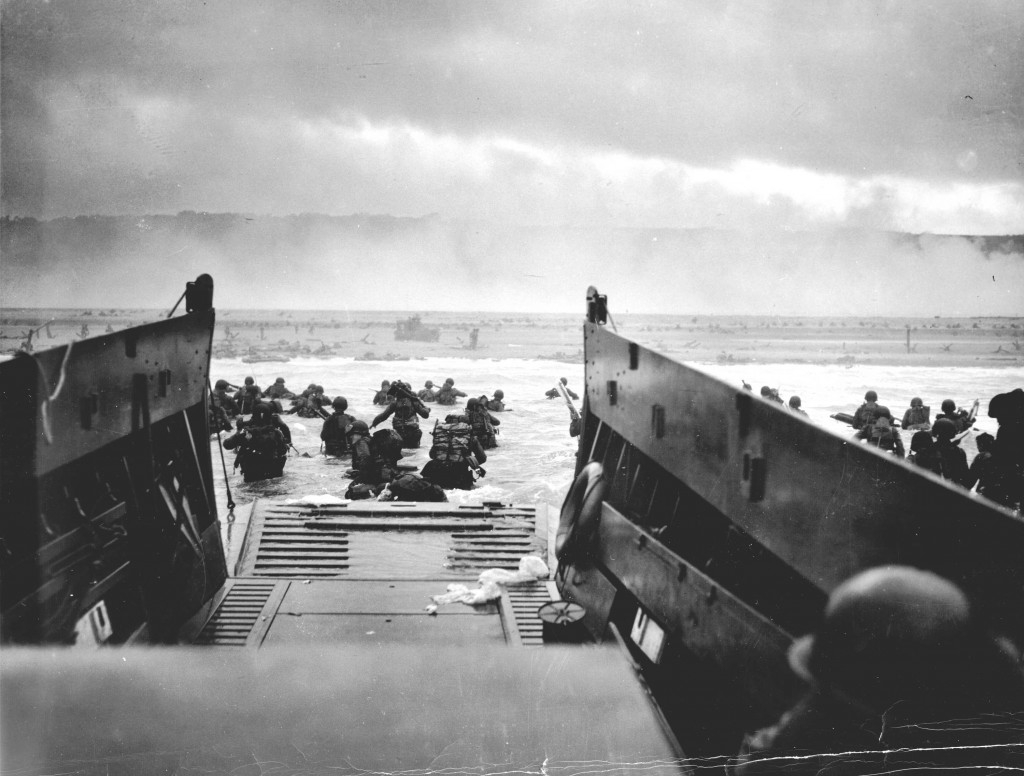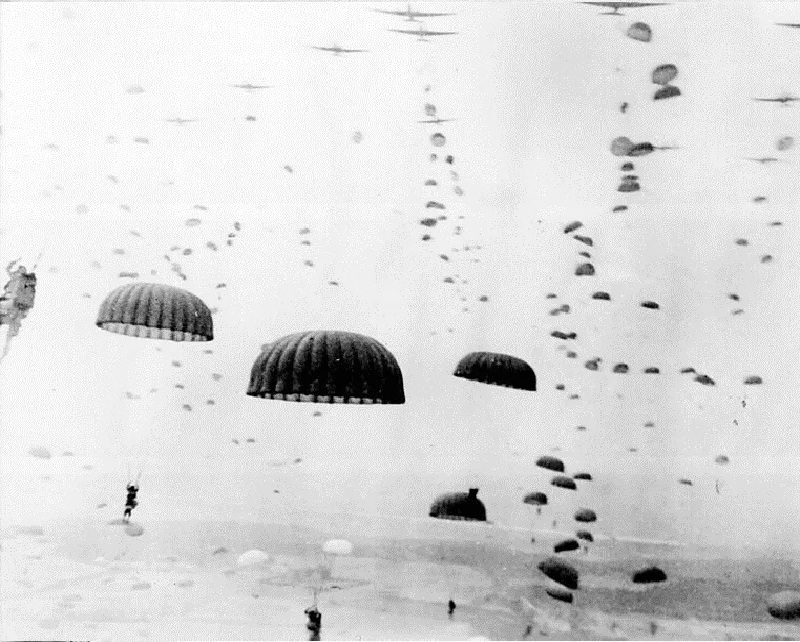

If you asked an 11-year-old boy how Omaha Beach could have been done
better, he would of course recommend a parachute drop. Okay, let's get this business over with.
FINGERS
The naval forces kerplow the beach with their big guns. Then four or five lines of bombers - "fingers" - approach from north to south to bomb the beach in four or five spots on the 5.9-kilometre Omaha Beach, from the water to a bit inland. This would be a barrage of thunderous explosions, with much wider shock waves.
This is extra speculative because during the actual D-Day the navy wanted to avoid having bombs dumped on them, so they forced the bombers to delay releasing their bombs. As a result the beach was (arguably) missed completely, one of the reasons the Omaha Beach landing went so badly.
Flying right behind each finger of bombers come lines of C-47 Skytrain planes carrying paratroopers. There would be no issue with paratroopers landing in the wrong spot or at the wrong time, at least relative to the bombers. Would they fly at different heights?
Are paratroopers available? I suspect all the U.S. paratroopers were used for the drops around Utah Beach. As for the Brits, some were not used on D-Day. They were eventually dumped into the failed Arnhem offensive ("a bridge too far"). There is also the issue of aircraft availability.
I don't believe dropping paratroopers into an area immediately after it was bombed has ever been done. It would be smoky. Heat goes up. Dropping on a fortified area had been done, successfully, by Germans at Fort Eben-Emael in 1940.
Following behind the paratroopers come the landing craft. The paratroopers are dealing with the fortified positions and opening up a path inland, while the troops coming in landing craft reinforce the vulnerable paratroopers, after working through barbed wire and mines. If the landing troops and the paratroopers don't connect they would both be in serious trouble.
It's nice to picture paratroopers landing right on top of the fortified positions. However, while I'm not an expert on parachute landings I suspect people in planes would err on the side of not dropping people in the ocean, and they would drop in a comfortable field, sort themselves out, then move north in good order (and not seasick). Between the thunderous, battering bombardment, agressive paratroopers moving toward them from an awkward direction and a horizon full of ships sending landing craft toward them from the opposite direction, I'm sure the defenders - not as numerous as you think - would be dealt with and a safe path would be opened up.
The advantage of this fingers approach is that German defensive positions
could be attacked, not head on but from the more vulnerable sides and rear by troops that had moved off the beach. Also some battlefield depth would be achieved within
hours minutes.
The way I see it, these parachute drops would be a bit different than
the ones that actually happened. It would not take place during the
black of night but at 6:30 a.m.. You would be looking for
the border of ocean and land, not a remote field. Since the planes are
not going deep inland they would not face as many anti-aircraft guns.
Would paratroopers be eaten up by anti-aircraft fire?
DIRTY FINGERS
During the actual landing at Omaha Beach the first wave was massacred, and subsequent waves were piled up in deadly chaos. With this new approach, fingers combined with waves of troops landing on the length of Omaha Beach, the first wave would be massacred, and subsequent waves would be piled up in deadly chaos, although things would get progressively better. So why not have troops land safely only in secured beach areas? There are four reasons not to do this:
1) The fustest with the mostest. Forget the beach battles. The Normandy campaign as a whole was a story of who could bring more forces to the battlefield faster than their opponent. Keep sending bodies moving south, alive or whatever, in a conveyer belt of wave after wave. Put yourself in the shoes of a defending German commander. Having troops land in secured areas means that these secured areas could be gradually expanded, but notice the word "gradually". You have to secure the draws so that tanks and other vehicles can move off the beach.
2) Concentration of fire. German artillery was presited for areas of Omaha Beach. An artillery observer just had to say a code word like "Elefant" and artillery fire from different sources would then be concentrated for a period of time, say, midway from the water's edge to the seawall on a specific section of the beach. There could also be concentration of fire in the approach to the beach.
3) Landing in certain spots could be messy. Much can go wrong already, but with fingers in random places people would have to improvise who goes where when on the fly (including navy men removing obstacles). Might the landing craft arrive in the wrong spot - which actually happened - or would navigation be easy?
4) Having troops land on the length of the beach would give an early boost to rolling up the flank as the defenders would be attacked from
multiple sides.
CLEAN FINGERS
With the clean fingers plan, troops would only land in the fingers areas. Ram, jam troops in those areas. Ships could still batter the non-finger shoreline so that gunners and artillery observers and anyone else in the area are having a bad day. This would go on for, I don't know, 15-20 minutes, as long as you can determine what you are shooting at. Eventually the secured beach areas would expand. Flares might be useful.
The disadvantages of this plan have been listed above. But consider
this: You know how in Saving Private Ryan the troops were massacred by
(among other things) machine guns shooting north at them?
Picture all the troops landing at Omaha Beach and none of them have to
face machine guns shooting north at them.

Modified
The key word here is fists, and after that it gets messy.
A number of groups of bombers fly south, bomb the beach, and paratroopers drop down right behind them. (Simplifying things) the regular troops who land in these areas will not face machine gun fire going north. But what about, say, the 50-mm. gun shooting down the length of the beach, aiming at the landing craft? That gun is situated outside the area of the paratroopers.
We'll have to use fists instead of fingers. A fist will cover a wider area. This is to ensure that regular troops are not hit by that gun off to the side. It also has the effect of guarding the flanks of the paratroopers because there are fewer flanks to guard.
The fists would be fewer in number than the fingers, say two. Maybe just one. It would only cover part of Omaha Beach.
I guess we're going with two wide groups of bombers going south toward Omaha Beach,
with two wide groups of planes with paratroopers following right on their tail.
There are still some tricky bombardment and timing issues to look at.
Some questions will have to be asked about altitude. I also wonder about
direction. Any ideas? Maybe there's a reason they didn't drop paratroopers next to
the beach.
There is an entirely different approach.
There was German artillery situated behind the beach
(here if you really care).
That artillery did cause a lot of casualties.
They could do a special operation to take out the artillery, as
was done at other Normandy locations on D-Day.
However, that's extra speculative because the Allies did not know about the 352nd infantry division and its artillery.
So no.
D-Day Static line Jump from a C-47 into Normandy
There are other clips like this. What would it sound like?
